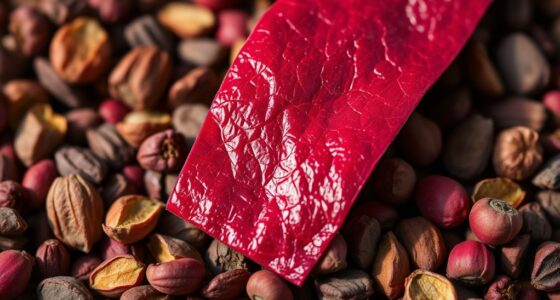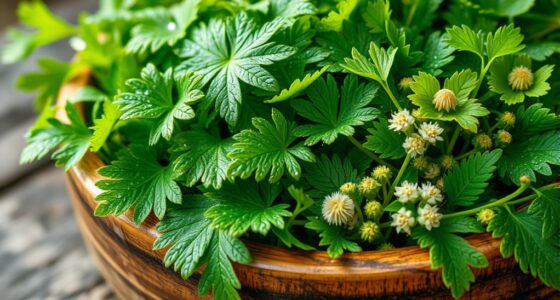To create tasty forage for your rabbits, sprouting grains is essential. Soak the grains for 24 hours, then water the sprouts twice daily, cutting them into small pieces for easy eating. Utilize a Three-Tray System with proper grow lights to ensure a constant supply. Sprouted grains provide increased nutrition, aid digestion, and simulate natural foraging. Offer different textures and scents, hide treats, and rotate the components of the mix to keep bunnies interested. Slowly introduce new types of forage, monitor their eating and stool habits, and consult a vet if necessary. Begin with plants that are free of pesticides, providing a variety of flavors to prevent boredom. Create enticing forage options to help rabbits stay active and healthy.
Key Takeaways
- Experiment with diverse textures and flavors for variety.
- Include a mix of rabbit-safe plants, herbs, and flowers.
- Ensure all forage plants are pesticide-free.
- Rotate ingredients to prevent boredom and stimulate rabbits.
- Monitor foraging habits to maintain interest and health.
Sprouting Grains for Rabbit Forage
To begin making forage for your rabbits, sprouting grains is an essential step in enhancing their nutritional intake.
When preparing rabbit pellets, soak the grains for 24 hours before starting the sprouting process. After two days, you'll notice the sprouts going through different growth stages, each offering unique nutritional benefits.
Remember to water the sprouts twice a day to promote peak growth and nutrient development.
To make it easier for your rabbits to consume, consider cutting the sprouted grains into small pieces. This step also encourages root mat development, important for maximizing digestibility and nutrient absorption.
By following these simple yet effective techniques, you can make sure that your rabbits receive a well-rounded and nutritious forage that caters to their dietary needs.
Stay tuned for more tips on how to set up a three-tray system for continuous forage production.
Setting up a Three-Tray System
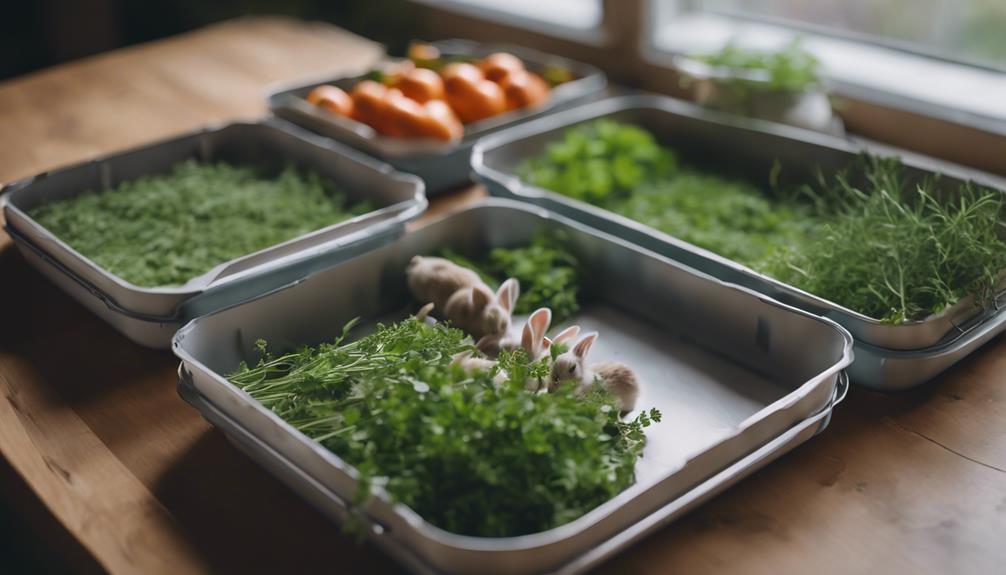
Setting up a three-tray system for sprouting grains involves stacking three trays on top of each other to facilitate continuous growth and harvesting of fresh fodder for your rabbits.
The top tray is where you place the soaked grains for initial sprouting. The middle tray houses the growing sprouts, while the bottom tray collects the mature fodder.
This system, as you might've learned a few days ago, allows for a steady rotation of grains at different growth stages, ensuring a constant supply of nutritious food for your bunnies.
By setting up this three-tray system, you're optimizing space and efficiency in growing fodder. Remember to regularly rotate the trays to promote consistent growth.
This simple yet effective method guarantees a good supply of fresh, healthy forage for your rabbits. Trust us; they'll appreciate the effort, hopping around with joy as they munch on the good stuff you've prepared for them.
Choosing the Right Grow Lights
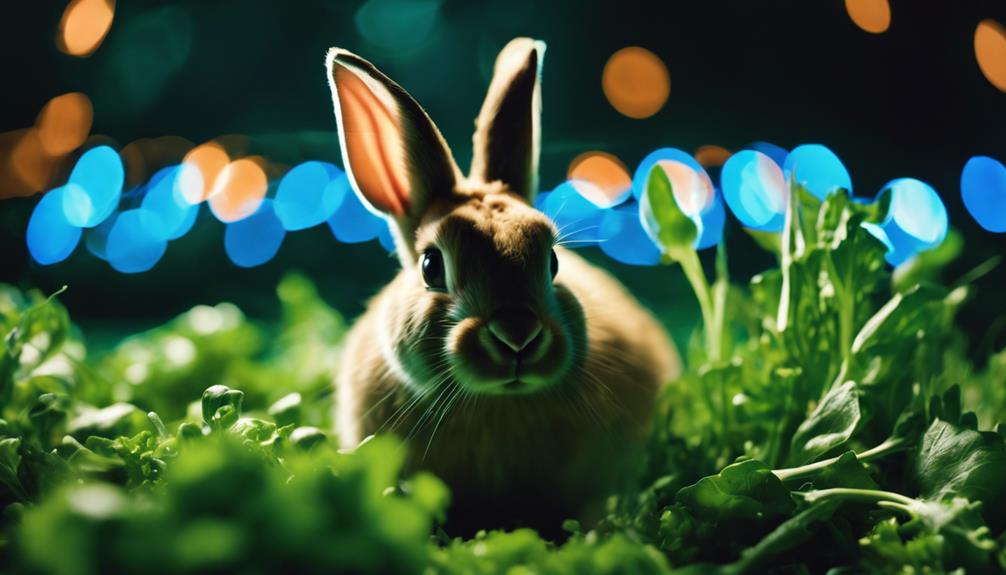
When it comes to optimizing the growth of your rabbit's forage, selecting the right grow lights is key. Here are some essential tips for choosing the right grow lights:
- Full Spectrum Essential: Full spectrum grow lights are essential for the best growth of your rabbit's forage as they provide the necessary light spectrum for photosynthesis in plants.
- Energy Efficient LEDs: LEDs are a popular choice for grow lights due to their energy efficiency and customizable spectrum, ensuring your plants get the right amount of light they need to thrive.
- Proper Lighting Schedule: A proper lighting schedule is important for the development of healthy and nutrient-rich forage. Ensuring your plants receive the right amount of light for the right number of hours each day is key.
- Impactful Quality Lights: Investing in quality grow lights can have a great impact on the success of your forage production, leading to better yields in just a little bit of time.
Choosing the right grow lights can make all the difference in producing delicious forage for your rabbits in just a few days.
Nutritional Benefits of Sprouted Grains
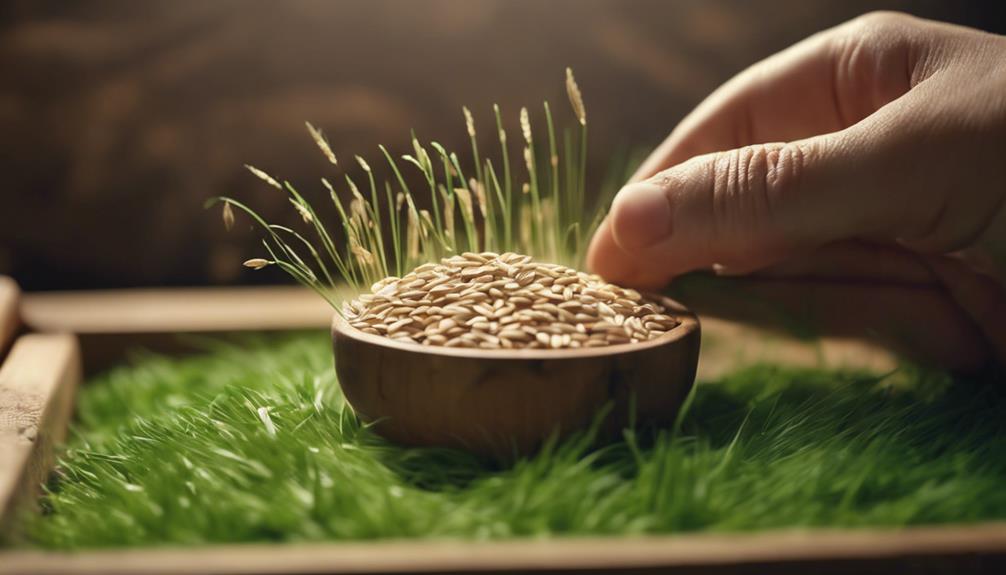
Sprouted grains offer a nutritional boost for your rabbits, enhancing their overall health.
The sprouting process increases enzyme activity and vitamin content, making nutrients more easily digestible and absorbable.
Sprouted Grains Boost Nutrition
Boost the nutritional value of rabbit forage by incorporating sprouted grains, known for their enhanced nutrient content and benefits for rabbit health.
Sprouted grains offer a plethora of advantages, including increased digestibility and a boost in essential nutrients essential for your rabbits' well-being. Here's why sprouted grains are a great addition to your rabbits' diet:
- Nutrient-Rich: Sprouted grains have increased nutritional value compared to unsprouted grains, providing essential vitamins and enzymes important for your rabbits' health.
- Enhanced Digestibility: The sprouting process enhances digestibility, making nutrients more accessible to your rabbits, ensuring they can efficiently absorb the goodness.
- Digestive Health: Rabbits fed sprouted grains are less likely to experience digestive issues, promoting a healthy gut and overall well-being.
- Foraging Behavior: Sprouted grains mimic rabbits' natural foraging behavior, offering mental stimulation and promoting physical health.
- Overall Health Benefits: By incorporating sprouted grains, you're offering your rabbits a well-rounded diet that supports their nutritional needs and overall health.
Enhanced Digestibility for Rabbits
Incorporating sprouted grains into your rabbits' diet enhances their digestibility, ensuring they can efficiently absorb essential nutrients for peak health. Sprouted grains offer increased nutritional value, packed with important enzymes and vitamins essential for your rabbits' well-being.
This boost in digestibility not only aids in nutrient absorption but also lowers the risk of digestive issues that can impact your rabbits' health. Additionally, rabbits seem to love sprouted wheat fodder, consuming the entire fodder without any wastage, making it a practical and enjoyable dietary addition.
By mimicking their natural foraging behavior, sprouted grains provide a more natural and wholesome diet for your rabbits, aligning with their dietary preferences. Remember to harvest sprouted grains at the right moment when a root mat forms and store them correctly in airtight containers to maintain freshness and maximize their nutritional benefits.
With enhanced digestibility from sprouted grains, your rabbits can thrive on a diet that optimizes their health and vitality.
Mimicking Natural Foraging Behavior

To mimic rabbits' natural foraging behavior, create a forage mix that encourages exploration and engages their instinctual search for food.
Incorporate a variety of textures and scents in the forage mix to stimulate rabbits' senses and keep them interested.
Hide small treats or pellets within the forage mix to encourage rabbits to actively search for their food, mimicking their wild scavenging behavior.
Scatter the forage mix in different areas of their enclosure to promote movement and exercise as they search for the hidden goodies.
Rotate the ingredients in the forage mix regularly to prevent boredom and keep the rabbits mentally stimulated.
Monitor your rabbits' foraging habits and adjust the mix accordingly to suit their preferences and maintain their interest in exploring their environment.
Maximizing Biomass Yield
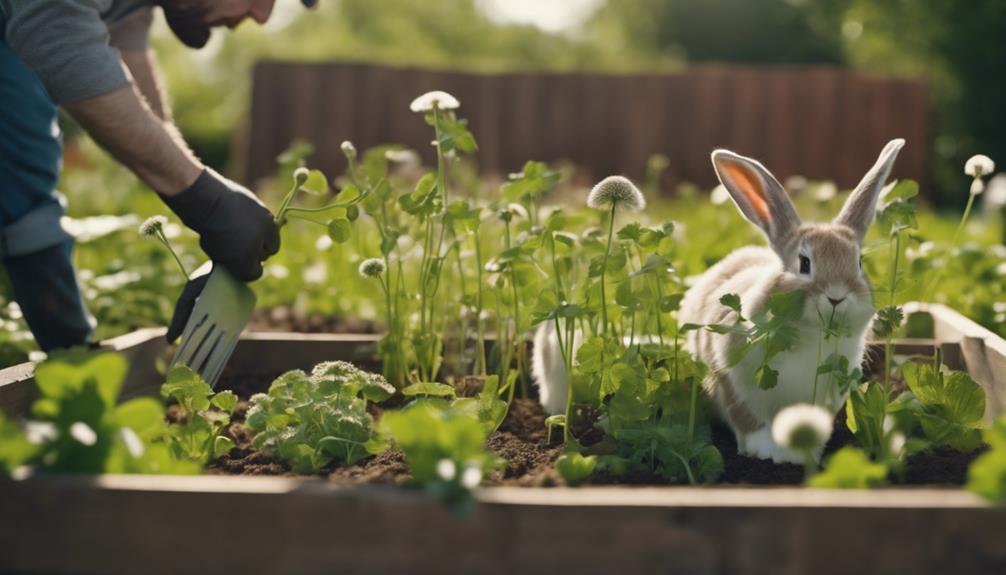
To maximize the biomass yield in fodder systems for rabbit forage, consider the use of full spectrum grow lights as an essential element for ideal growth. These lights provide a broad spectrum of light that mimics natural sunlight, promoting photosynthesis and robust plant development.
Watering the sprouts twice a day is vital for ensuring ideal growth and high biomass production. Harvesting the sprouted grains when the root mat forms is key to achieving a substantial biomass yield for your rabbits.
Sprouted grains offer a cost-effective and nutrient-rich way to maximize biomass for rabbit forage, providing essential nutrients for your rabbits' health and well-being. By incorporating full spectrum grow lights, proper watering techniques, and timely harvesting practices, you can make sure that your fodder system produces a bountiful biomass of sprouted grains to meet your rabbits' foraging needs effectively.
Ensuring Digestibility for Rabbits

Guaranteeing digestibility for rabbits involves providing a diverse range of forage types such as timothy hay, orchard grass, and oat hay.
To maintain your rabbits' digestive health, follow these key guidelines:
- Avoid Contaminated Forage: Never feed your rabbits forage that's dusty, moldy, or contaminated, as this can lead to digestive issues.
- Introduce New Forage Gradually: Prevent gastrointestinal upset by slowly introducing new forage types into your rabbits' diet.
- Monitor Stool Consistency: Keep an eye on your rabbits' stool consistency as it can indicate how well they're digesting the forage provided.
- Observe Eating Habits: Pay attention to your rabbits' eating habits to ensure they're consuming forage effectively.
- Consult with a Veterinarian: Seek advice from a veterinarian to determine the best forage mix for your rabbits' specific digestive needs.
Minimizing Waste With DIY Forage
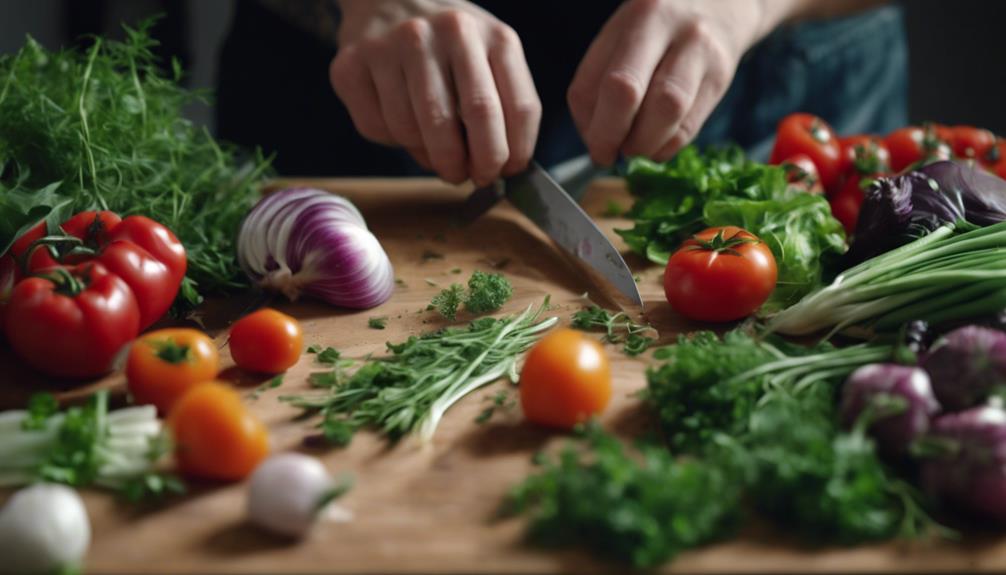
Repurposing leftover vegetables and herbs can help you minimize waste by creating a personalized forage mix for your rabbits. By using a dehydrator to dry out ingredients like carrots, parsley, and dandelion leaves, you can extend their shelf life and reduce spoilage. Incorporating hay, pellets, and forage not only provides a well-rounded diet for your rabbits but also helps in utilizing surplus produce effectively. Experimenting with different textures and flavors keeps your rabbits engaged and interested in their forage mix, preventing boredom and encouraging foraging behavior.
To further aid in waste minimization, consider the following DIY forage mix components:
| Ingredient | Purpose |
|---|---|
| Leftover Veggies | Nutritious base for the forage mix |
| Dehydrated Herbs | Flavor enhancement and extended shelf life |
| Hay | Fiber source for digestive health |
| Pellets | Balanced nutrition supplement |
| Forage | Mimics natural grazing behavior |
Tips for Successful Forage Production
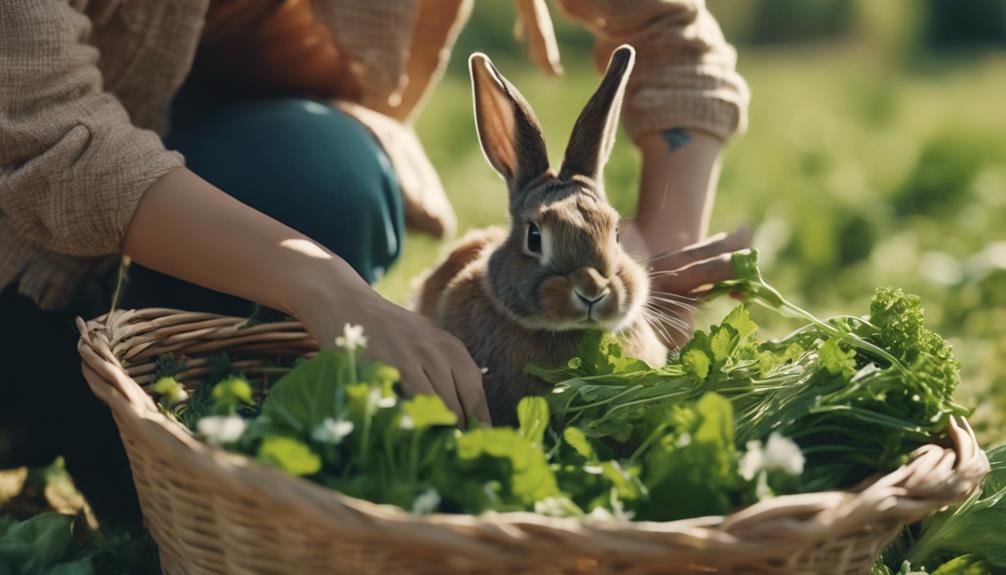
Select a diverse range of rabbit-safe plants, herbs, and flowers to guarantee successful forage production for your rabbits.
Here are some tips to help you achieve a thriving forage supply:
- Variety is Key: Choose a mix of plants to provide different flavors and nutrients for your rabbits.
- Pesticide-Free Zone: Make sure all forage plants are free from pesticides and chemicals to keep your rabbits healthy.
- Timing Matters: Harvest forage early in the morning when plants are at their freshest and most nutritious.
- Dry it Out: Thoroughly dry the forage before storage to prevent molding and spoilage, and store it in a cool, dry place.
- Rotate Regularly: Keep things interesting for your rabbits by rotating the types of forage you provide, offering a varied diet to prevent boredom and ensure balanced nutrition.
Frequently Asked Questions
How to Make Forage for Rabbits?
To make forage for rabbits, gather safe herbs, flowers, and grasses. Dry them thoroughly, mix in the right ratios, and store in a cool place. Offer this mix as a healthy snack. Your rabbits will love it!
What Is the Best Forage for Rabbits?
To provide the best forage for your rabbits, offer a mix of safe plants like dandelion greens, mint, parsley, and cilantro. Remember to introduce forage gradually, monitor their preferences, and incorporate various textures and flavors for mental stimulation.
How to Make Hay More Appealing to Rabbits?
To make hay more appealing to your rabbits, try mixing in fresh herbs, dried fruits, and flower petals. Rotate hay types for variety and stuff it in creative feeders. Keep them entertained and satisfied with these simple tricks.
What Do You Feed Rabbits When Foraging?
When foraging for rabbits, feed them a mix of fresh greens, herbs, flowers, and vegetables. Include safe options like dandelion greens, parsley, cilantro, and mint. Rotate forage types for varied nutrients and flavors. Avoid toxic plants and tailor based on their preferences and nutritional needs.
Conclusion
So remember, with just a little time and effort, you can transform your rabbit's forage into a gourmet experience they'll devour with delight.
Sprouting grains, setting up a three-tray system, and choosing the right grow lights are key to guaranteeing success.
Mimicking natural foraging behavior and maximizing biomass yield will make certain your rabbits are well-fed and happy.
So go ahead and become the master chef of rabbit forage, your furry friends will thank you!



